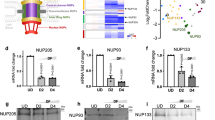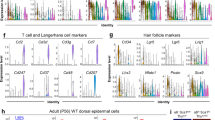Abstract
p53 homologue, p51/p63, predominantly expressed in keratinocyte stem cells, is indispensable for the formation of epidermis. Notch1, another such gene indispensable for the process, induces growth arrest and differentiation in keratinocytes. We found that exogenous expression of ΔNp51B (ΔNp63α), one of the isoforms of p51 specifically expressed in basal keratinocytes, blocked Notch 1-dependent growth arrest and differentiation in mouse keratinocytes by inhibiting p21 expression and maintaining integrins expression. Furthermore, ΔNp51B by itself was found to have ability to induce expression of integrin α6β4, which promotes attachment of basal cells to basal membrane thereby keeping the cells in immature state. Therefore, we conclude that ΔNp51B expression warrants integrin expression even under the influence of Notch1 and that ΔNp51B is a long-sought factor required to maintain basal cell keratinocytes immaturity by inhibiting Notch1 activity. We will postulate a plausible model explaining the maintenance of the squamous epithelium architectures as well as offering mechanistic explanations for pathological features of skin diseases, including cancers, psoriasis along with physiological wound healings.
This is a preview of subscription content, access via your institution
Access options
Subscribe to this journal
Receive 50 print issues and online access
$259.00 per year
only $5.18 per issue
Buy this article
- Purchase on Springer Link
- Instant access to full article PDF
Prices may be subject to local taxes which are calculated during checkout






Similar content being viewed by others
References
Artavanis-Tsakonas S, Rand MD, Lake RJ . (1999). Notch signaling: cell fate control and signal integration in development. Science 284: 770–776.
Bourdon JC, Fernandes K, Murray-Zmijewski F, Liu G, Diot A, Xirodimas DP et al. (2005). p53 isoforms can regulate p53 transcriptional activity. Genes Dev 19: 2122–2137.
Celli J, Duijf P, Hamel BC, Bamshad M, Kramer B, Smits AP et al. (1999). Heterozygous germline mutations in the p53 homolog p63 are the cause of EEC syndrome. Cell 99: 143–153.
Crook T, Nicholls JM, Brooks L, O'Nions J, Allday MJ . (2000). High level expression of deltaN-p63: a mechanism for the inactivation of p53 in undifferentiated nasopharyngeal carcinoma (NPC)? Oncogene 19: 3439–3444.
Cui R, He J, Mei R, de Fromentel CC, Martel-Planche G, Taniere P et al. (2005). Expression of p53, p63, and p73 isoforms in squamous cell carcinoma and adenocarcinoma of esophagus. Biochem Biophys Res Commun (in press).
Dajee M, Lazarov M, Zhang JY, Cai T, Green CL, Russell AJ et al. (2003). NF-kappaB blockade and oncogenic Ras trigger invasive human epidermal neoplasia (see comment). Nature 421: 639–643.
Dohn M, Zhang S, Chen X . (2001). p63alpha and DeltaNp63alpha can induce cell cycle arrest and apoptosis and differentially regulate p53 target genes. Oncogene 20: 3193–3205.
Donehower LA, Harvey M, Slagle BL, McArthur MJ, Montgomery Jr CA, Butel JS et al. (1992). Mice deficient for p53 are developmentally normal but susceptible to spontaneous tumours. Nature 356: 215–221.
Duijf PH, Vanmolkot KR, Propping P, Friedl W, Krieger E, McKeon F et al. (2002). Gain-of-function mutation in ADULT syndrome reveals the presence of a second transactivation domain in p63. Hum Mol Genet 11: 799–804.
Fuchs E . (1990). Epidermal differentiation: the bare essentials. J Cell Biol 111: 2807–2814.
Hagiwara K, McMenamin MG, Miura K, Harris CC . (1999). Mutational analysis of the p63/p73L/p51/p40/CUSP/KET gene in human cancer cell lines using intronic primers. Cancer Res 59: 4165–4169.
Hennings H, Michael D, Cheng C, Steinert P, Holbrook K, Yuspa SH . (1980). Calcium regulation of growth and differentiation of mouse epidermal cells in culture. Cell 19: 245–254.
Hibi K, Trink B, Patturajan M, Westra WH, Caballero OL, Hill DE et al. (2000). AIS is an oncogene amplified in squamous cell carcinoma. Proc Natl Acad Sci USA 97: 5462–5467.
Hu Y, Baud V, Delhase M, Zhang P, Deerinck T, Ellisman M et al. (1999). Abnormal morphogenesis but intact IKK activation in mice lacking the IKKalpha subunit of IkappaB kinase. Science 284: 316–320.
Huber MA, Azoitei N, Baumann B, Grunert S, Sommer A, Pehamberger H et al. (2004). NF-kappaB is essential for epithelial-mesenchymal transition and metastasis in a model of breast cancer progression. Journal of Clinical Investigation 114: 569–581.
Ikawa S, Nakagawara A, Ikawa Y . (1999). p53 family genes: structural comparison, expression and mutation. Cell Death Differ 6: 1154–1161.
Jarriault S, Brou C, Logeat F, Schroeter EH, Kopan R, Israel A . (1995). Signalling downstream of activated mammalian Notch. Nature 377: 355–358.
Koster MI, Kim S, Mills AA, DeMayo FJ, Roop DR . (2004). p63 is the molecular switch for initiation of an epithelial stratification program. Genes Dev 18: 126–131.
Mainiero F, Murgia C, Wary KK, Curatola AM, Pepe A, Blumemberg M et al. (1997). The coupling of alpha6beta4 integrin to Ras-MAP kinase pathways mediated by Shc controls keratinocyte proliferation. EMBO J 16: 2365–2375.
McGrath JA, Duijf PH, Doetsch V, Irvine AD, de Waal R, Vanmolkot KR et al. (2001). Hay-Wells syndrome is caused by heterozygous missense mutations in the SAM domain of p63. Hum Mol Genet 10: 221–229.
Mills AA . (2006). p63: oncogene or tumor suppressor? Curr Opin Genet Dev 16: 38–44.
Mills AA, Zheng B, Wang XJ, Vogel H, Roop DR, Bradley A . (1999). p63 is a p53 homologue required for limb and epidermal morphogenesis. Nature 398: 708–713.
Nguyen BC, Lefort K, Mandinova A, Antonini D, Devgan V, Della Gatta G et al. (2006). Cross-regulation between Notch and p63 in keratinocyte commitment to differentiation. Genes Dev 20: 1028–1042.
Nicolas M, Wolfer A, Raj K, Kummer JA, Mill P, van Noort M et al. (2003). Notch1 functions as a tumor suppressor in mouse skin. Nat Genet 33: 416–421.
Okuyama R, Nguyen BC, Talora C, Ogawa E, Tommasi di Vignano A, Lioumi M et al. (2004). High commitment of embryonic keratinocytes to terminal differentiation through a Notch1-caspase 3 regulatory mechanism. Dev Cell 6: 551–562.
Osada M, Ohba M, Kawahara C, Ishioka C, Kanamaru R, Katoh I et al. (1998). Cloning and functional analysis of human p51, which structurally and functionally resembles p53. Nat Med 4: 839–843.
Park BJ, Lee SJ, Kim JI, Lee CH, Chang SG, Park JH et al. (2000). Frequent alteration of p63 expression in human primary bladder carcinomas. Cancer Res 60: 3370–3374.
Parsa R, Yang A, McKeon F, Green H . (1999). Association of p63 with proliferative potential in normal and neoplastic human keratinocytes. J Invest Dermatol 113: 1099–1105.
Patturajan M, Nomoto S, Sommer M, Fomenkov A, Hibi K, Zangen R et al. (2002). DeltaNp63 induces beta-catenin nuclear accumulation and signaling. Cancer Cell 1: 369–379.
Rangarajan A, Talora C, Okuyama R, Nicolas M, Mammucari C, Oh H et al. (2001). Notch signaling is a direct determinant of keratinocyte growth arrest and entry into differentiation. EMBO J 20: 3427–3436.
Ratovitski EA, Patturajan M, Hibi K, Trink B, Yamaguchi K, Sidransky D . (2001). p53 associates with and targets Delta Np63 into a protein degradation pathway. Proc Natl Acad Sci USA 98: 1817–1822.
Serber Z, Lai HC, Yang A, Ou HD, Sigal MS, Kelly AE et al. (2002). A C-terminal inhibitory domain controls the activity of p63 by an intramolecular mechanism. Mol Cell Biol 22: 8601–8611.
Shang Y, Hu X, DiRenzo J, Lazar MA, Brown M . (2000). Cofactor dynamics and sufficiency in estrogen receptor-regulated transcription. Cell 103: 843–852.
Stiewe T, Zimmermann S, Frilling A, Esche H, Putzer BM . (2002). Transactivation-deficient DeltaTA-p73 acts as an oncogene. Cancer Res 62: 3598–3602.
Takeda K, Takeuchi O, Tsujimura T, Itami S, Adachi O, Kawai T et al. (1999). Limb and skin abnormalities in mice lacking IKKalpha. Science 284: 313–316.
Thelu J, Rossio P, Favier B . (2002). Notch signalling is linked to epidermal cell differentiation level in basal cell carcinoma, psoriasis and wound healing. BMC Dermatol 2: 7.
Uyttendaele H, Panteleyev AA, de Berker D, Tobin DT, Christiano AM . (2004). Activation of Notch1 in the hair follicle leads to cell-fate switch and Mohawk alopecia. Differentiation 72: 396–409.
Wu G, Nomoto S, Hoque MO, Dracheva T, Osada M, Lee CC et al. (2003). DeltaNp63alpha and TAp63alpha regulate transcription of genes with distinct biological functions in cancer and development. Cancer Res 63: 2351–2357.
Yang A, Kaghad M, Wang Y, Gillett E, Fleming MD, Dotsch V et al. (1998). p63, a p53 homolog at 3q27–29, encodes multiple products with transactivating, death-inducing, and dominant-negative activities. Mol Cell 2: 305–316.
Yang A, McKeon F . (2000). P63 and P73: P53 mimics, menaces and more. Nat Rev Mol Cell Biol 1: 199–207.
Yang A, Schweitzer R, Sun D, Kaghad M, Walker N, Bronson RT et al. (1999). p63 is essential for regenerative proliferation in limb, craniofacial and epithelial development. Nature 398: 714–718.
Yang A, Walker N, Bronson R, Kaghad M, Oosterwegel M, Bonnin J et al. (2000). p73-deficient mice have neurological, pheromonal and inflammatory defects but lack spontaneous tumours. Nature 404: 99–103.
Zhu AJ, Haase I, Watt FM . (1999). Signaling via beta1 integrins and mitogen-activated protein kinase determines human epidermal stem cell fate in vitro. Proc Natl Acad Sci USA 96: 6728–6733.
Acknowledgements
This study was partly supported by a Grant in Aid from the Ministry of Education, Culture, Sports, Science, and Technology of the Japanese government.
Author information
Authors and Affiliations
Corresponding author
Rights and permissions
About this article
Cite this article
Okuyama, R., Ogawa, E., Nagoshi, H. et al. p53 homologue, p51/p63, maintains the immaturity of keratinocyte stem cells by inhibiting Notch1 activity. Oncogene 26, 4478–4488 (2007). https://doi.org/10.1038/sj.onc.1210235
Received:
Revised:
Accepted:
Published:
Issue Date:
DOI: https://doi.org/10.1038/sj.onc.1210235
Keywords
This article is cited by
-
Unravelling disparate roles of NOTCH in bladder cancer
Nature Reviews Urology (2018)
-
Genomic insights into head and neck cancer
Cancers of the Head & Neck (2016)
-
Targeting cellular and molecular drivers of head and neck squamous cell carcinoma: current options and emerging perspectives
Cancer and Metastasis Reviews (2016)
-
Opposing functions of Fbxw7 in keratinocyte growth, differentiation and skin tumorigenesis mediated through negative regulation of c-Myc and Notch
Oncogene (2013)
-
Epidermal FABP (FABP5) Regulates Keratinocyte Differentiation by 13(S)-HODE-Mediated Activation of the NF-κB Signaling Pathway
Journal of Investigative Dermatology (2011)



